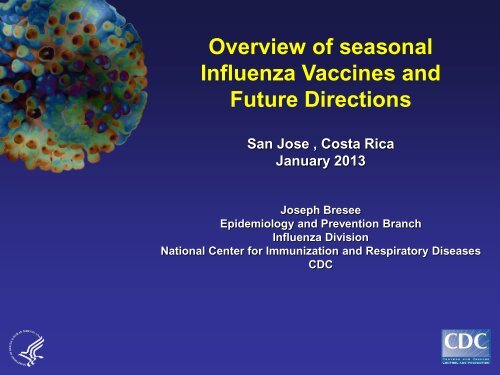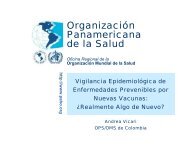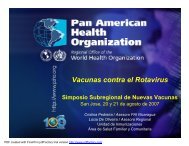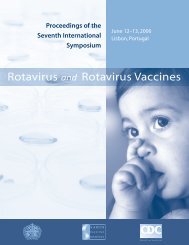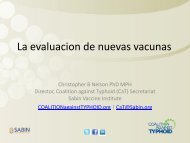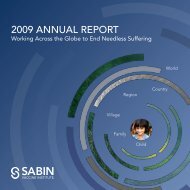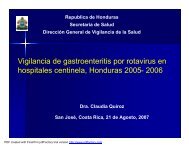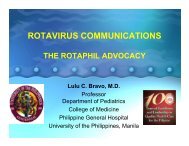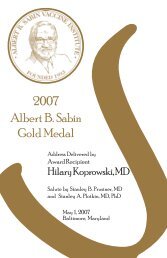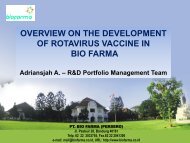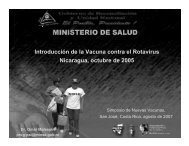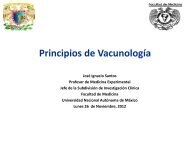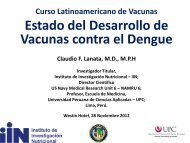Joseph Breese - Sabin Vaccine Institute
Joseph Breese - Sabin Vaccine Institute
Joseph Breese - Sabin Vaccine Institute
You also want an ePaper? Increase the reach of your titles
YUMPU automatically turns print PDFs into web optimized ePapers that Google loves.
Overview of seasonal<br />
Influenza <strong>Vaccine</strong>s and<br />
Future Directions<br />
San Jose , Costa Rica<br />
January 2013<br />
<strong>Joseph</strong> Bresee<br />
Epidemiology and Prevention Branch<br />
Influenza Division<br />
National Center for Immunization and Respiratory Diseases<br />
CDC
Overview<br />
• Influenza vaccines<br />
– Types, composition<br />
• <strong>Vaccine</strong> safety<br />
• <strong>Vaccine</strong> effectiveness<br />
• Vaccination strategies<br />
– Risk-based vs. Universal vaccination<br />
• Challenges and opportunities in the next few years
Seasonal Influenza <strong>Vaccine</strong>s<br />
INFLUENZA VACCINES
Influenza <strong>Vaccine</strong>s<br />
• Best tool for preventing<br />
influenza<br />
– <strong>Vaccine</strong>s are<br />
component of multipart<br />
strategy for<br />
influenza control<br />
• with hygiene, antivirals,<br />
quality medical<br />
treatment, NPIs
Clinical trials of inactivated vaccines<br />
• Inactivated influenza vaccines have<br />
been available for decades<br />
• Early development of vaccines was<br />
done by US military<br />
• Extensive clinical trial data was<br />
collected in young, healthy military<br />
populations<br />
• Outcomes were serologic evidence of<br />
infection or serologically confirmed<br />
illness, not prevention of influenza<br />
complications
Percent Protection<br />
100<br />
Efficacy of inactivated influenza<br />
vaccines, 1943-1969<br />
75<br />
50<br />
25<br />
0<br />
A(H1N1) 1943<br />
B 1945<br />
A(H1N1) 1950<br />
A(H1N1) 1951<br />
A(H1N1) 1953<br />
B 1955<br />
A(H1N1) 1957<br />
A(H2N2) 1957<br />
A(H2N2) 1958<br />
B 1958<br />
A(H2N2) 1960<br />
A(H3N2) 1968<br />
A( H3N2) 1969<br />
Type of Virus, Year<br />
Courtesy A. Monto
Influenza <strong>Vaccine</strong>s - overview<br />
• Trivalent (H1N1, H3N2, B)<br />
– Quadrivalent fomulations now or soon licensed that<br />
include 2 B virus antigens<br />
• Annual vaccination required for optimal protection<br />
– Antigenic changes in circulating strains<br />
– <strong>Vaccine</strong>-induced antibodies wane over time<br />
• Influenza vaccine programs:<br />
– Conducted as seasonal campaigns (before local disease<br />
peaks)<br />
– (Mostly) target persons at high-risk of severe outcomes<br />
16
Approved seasonal influenza vaccines:<br />
types<br />
Inactivated vaccines<br />
“Standard” Inactivated vaccines<br />
Intradermal Inactivated vaccines<br />
High-dose Inactivated vaccine<br />
Adjuvanted inactivated vaccines<br />
Live attenuated vaccines
Influenza vaccines: types<br />
“Standard” Inactivated vaccines<br />
• Many manufacturers<br />
• Intramuscular injection<br />
• 0.5cc per dose<br />
• often decreased to 0.25cc for children 6-35 months<br />
• Contains 15 µg hemagglutinin of each virus strain per 0.5cc dose<br />
• 6 months of age or older – products vary<br />
• Protection primarily mediated by humoral immunity against the<br />
hemagglutinin protein<br />
• Protection correlated with serum antibody levels postvaccination
Influenza vaccines: types<br />
Intradermal Inactivated vaccines<br />
• Sanofi Pasteur<br />
• Injected Intradermally using<br />
special syringe and needle<br />
• Lower antigen content per<br />
dose (9 µg per virus strain)<br />
• Lower volume (0.1cc)<br />
• Licensed in US for 18-64 y-o<br />
• Potential advantages<br />
• Acceptability among needlephobic<br />
persons<br />
• Antigen-sparing<br />
Fluzone Intradermal Microinjection Syringe
Influenza vaccines: types<br />
High-dose Inactivated vaccine<br />
• Sanofi Pasteur<br />
• Intramuscular Injection<br />
• 0.5 cc per dose<br />
• Contains 60µg of each antigen per 0.5cc dose<br />
• Licensed in US for >65 year-olds<br />
• Advantages: better immune response may<br />
mean improved effectiveness in persons who<br />
respond poorly to standard dose vaccines (e.g.<br />
elderly)<br />
• More injection-site reactions – mostly mild
Influenza vaccines: types<br />
Live attenuated vaccines<br />
• Medimmune; Russia; others in development<br />
• Delivered by nasal spray or dropper<br />
o (0.2cc divided into each nostril)<br />
• Nonpregnant, healthy individuals ages 2-49 years<br />
o Includes most HCWs<br />
o Excludes children 2-4 yrs with asthma or wheezing in last year<br />
• Potential advantages:<br />
o Ease of use<br />
o No needles<br />
o Induction of broader immunity (cell-mediated); increased<br />
heterosubtypic protection<br />
o Potentially longer-lasting immunity<br />
o Superior effectiveness in children<br />
• Limited availability
Seasonal Influenza <strong>Vaccine</strong>s<br />
VACCINE EFFECTIVENESS
www.cdc.gov/flu<br />
<strong>Vaccine</strong> effectiveness<br />
• Effectiveness is variable from year to year<br />
and among populations<br />
• Generally lower than routine EPI vaccines<br />
• Factors that affect true vaccine effectiveness<br />
• Antigenic relatedness between vaccine virus to circulating<br />
strains<br />
• Host factors<br />
• Age (immune responses in very young and very old)<br />
• Underlying illnesses<br />
• <strong>Vaccine</strong> type<br />
• Programmatic issues
Influenza <strong>Vaccine</strong> efficacy if IIV in adults:<br />
meta-analyses<br />
Study<br />
Demicheli, et al<br />
(2000)<br />
Demicheli, et al<br />
(2009)<br />
Osterholm, et al<br />
(2012)<br />
No. studies<br />
reviewed<br />
Population Outcome VE<br />
10 Adults Lab-confirmed<br />
influenza<br />
38 Adults Lab-confirmed<br />
influenza<br />
8 18-65 y Lab-confirmed<br />
influenza<br />
68 (49-79)<br />
80 (56 – 91) [good match]<br />
50 (27-65) [poor match]<br />
59 (51-67)
Meta-analyses of influenza vaccine<br />
LAIV<br />
efficacy/effectiveness in children<br />
Reference<br />
No. studies /<br />
subjects Age range Study types<br />
Summary<br />
VE %<br />
Rhorer (2009) 9 / 27,000 6-71 m RCTs 72<br />
Negri (2005) 6 / 4400 6 m–18 y RCT / Obs 80 (53-91)<br />
Jefferson (2008) 34 < 16 y RCT / Obs. 82 (71-89)<br />
Osterholm<br />
(2012)<br />
TIV<br />
10 6m - 7 y RCT 83 (69-91)<br />
Jefferson (2008) 34 < 16 y RCT /Obs 59 (41-71)<br />
Negri (2005) 6 /2300 6 m–18 y RCT / Obs 65 (45-77)
<strong>Vaccine</strong> effectiveness: special populations:<br />
Elderly persons<br />
– Lower VE measured in elderly populations<br />
– Studies difficult because<br />
• RCTs rare because flu vaccine long-recommended in<br />
this group<br />
• Confounding in observational studies<br />
– Even so, well-done RCT and observational studies<br />
able to measure significant reductions in disease<br />
• Only RCT of influenza vaccine VE in the elderly<br />
(Govaert et al. JAMA. 1994;272:1661-1665)<br />
• Subjects: aged ≥60, generally healthy<br />
• VE overall = 50% (CI: 39 - 65)<br />
• 60-69 years: 57% (CI: 33 - 72)<br />
• >70: 23% (CI: -51 - 61)
<strong>Vaccine</strong> effectiveness: special populations:<br />
Pregnant Women<br />
• Influenza vaccination of mothers during<br />
pregnancy effective in reducing influenza<br />
associated hospitalization of their infants
Indirect effects of influenza vaccination<br />
• Monto JID, 1973 Tecumseh study<br />
• From 1968 pandemic, vaccination of school children reduced<br />
illness in children and adults compared to town that did not<br />
vaccinate children<br />
• Loeb JAMA 2009<br />
• Recent study of Hutterite communities in Canada<br />
• Found 61% reduction in adult cases of influenza by vaccinating<br />
children<br />
• Hospital-based HCP vaccination reduced nosocomial<br />
influenza<br />
• Salgado, et al. Infect Control Hospital Epidemiol 2004<br />
• Health care worker vaccination in nursing homes reduces<br />
patient deaths<br />
• Oshitani, et al; Potter, et al; Carmen, et al; Hayward et al.<br />
• Referenced in HCP Vaccination MMWR November 25, 2011
Communication of influenza vaccine<br />
effectiveness is difficult…<br />
www.cdc.gov/flu
Estimates number of medically-attended<br />
illnesses averted by vaccinations, 2005-2011<br />
Year All ages 0-4 yrs 5-19 yrs 20-64 yrs 65+ yrs<br />
2005-06 563,283 123,267 83,778 120,068 236,170<br />
2006-07 427,268 127,611 82,292 104,395 112,969<br />
2007-08 1,252,794 191,014 159,793 366,488 535,500<br />
2008-09 753,121 223,719 243,485 186,274 109,642<br />
2010-11 2,064,835 349,926 504,112 673,905 536,891<br />
Five<br />
Season<br />
Total<br />
5,708,895 1,214,683 1,301,920 1,630,509 1,561,782<br />
• Illness/outcomes averted may be an easier and more<br />
meaningful way to communicate the value of the vaccine?
Seasonal Influenza <strong>Vaccine</strong>s<br />
VACCINATION STRATEGIES
Influenza vaccines have been part of<br />
U.S. public health programs since 1960<br />
Burney LE. Public Health Rep.<br />
1960 Oct;75(10):944
Influenza vaccination recommendations over time<br />
Before 2000:<br />
Persons aged 65 or older<br />
Persons with high-risk chronic medical conditions<br />
Pregnant women in the second or third trimester<br />
Household contacts of the above<br />
Health care workers<br />
2000: Adults 50 and older<br />
2004: Children aged 6—23 months<br />
Household contact of children aged 0--23 months<br />
Women who will be pregnant during influenza season<br />
2006: Children aged 6—59 months<br />
Household contacts of children aged 0—59 months<br />
2008: All children aged 6 months—18 years<br />
2010: All persons > 6 months in the US
Seasonal Influenza <strong>Vaccine</strong>s<br />
CHALLENGES AND NEXT<br />
STEPS
Challenges<br />
Expanding or introducing influenza vaccine<br />
programs is challenging:<br />
• Variety of vaccine products/types<br />
• Developing policy requires a solid evidence base<br />
(e.g. risk groups, timing of campaign)<br />
• Most risk groups are not those targeted by routine<br />
EPI vaccines – new partners, training, etc.<br />
• Communicating value is complicated<br />
• Need for annual vaccination
Gaps<br />
• Most partners need education on the need / value of<br />
the vaccine<br />
• Relative benefit of annual campaigns in countries<br />
with substantial year-round disease is poorly<br />
understood<br />
• Relatively few data on the performance of vaccine<br />
in developing country populations<br />
• Disease burden and economic burden (or CE of<br />
vaccine) poorly understood in many places (but<br />
data being generated quickly)<br />
• NRAs gaining experience with approval of influenza<br />
vaccines
Opportunities<br />
• New developers and producers of influenza<br />
vaccines<br />
– Capacity has increased dramatically and will<br />
continue to<br />
• Interest in influenza prevention post-pandemic<br />
– Will wane quickly though<br />
• Substantial and high quality surveillance and<br />
disease burden data now available for most<br />
countries<br />
• New WHO SAGE recommendations to use vaccine
THANK YOU


